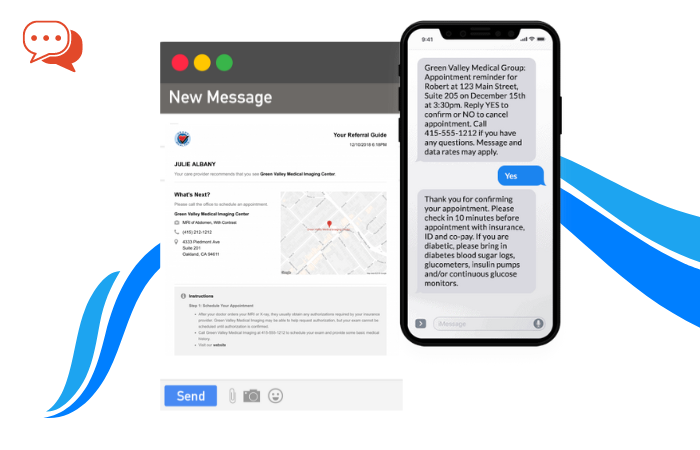What is Healthcare CRM Software and how can you select one to help bridge gaps between patient demand and practice delivery?
Today’s consumers have grown accustomed to digital experiences that increasingly personalize their interaction with any brand. The need to attract new patients through digital means is forcing healthcare into a new era of on-demand patient consumerism. The development of new platforms and technologies force healthcare organizations to adapt to deliver exactly what patients want. What do they want? Personalized, value-added, on-demand care delivery. How do we know if we are meeting patient needs? Through Healthcare CRM Software.
While electronic health records (EHRs) allow us to respond to some of these demands, we have entered into a new era of managing patient satisfaction and providing them with the kind of customer service they demand through customer relationship management (CRM) platforms. These tools allow practices to engage patients in new ways, optimizing the relationship between your practice and a demographic population.

What Is a CRM?
HIMSS has a definition for CRM technology that not only defines this tool for us but also suggests how to use them in our practice:
Customer Relationship Management (CRM) in healthcare is an organization-wide strategy for managing an organization’s interactions with its patients and their supporting infrastructure, suppliers, providers, and/or employees using CRM technologies. It seeks to optimize the way we establish and nurture meaningful and sustainable relationships in efforts to enhance patient experience, improve population health, reduce costs and improve the work life of healthcare providers – ultimately leading to increased trust in and loyalty to the organization.
Many practice owners and administrators may view this definition with skepticism. We have, after all, lived through the empty promises that our EHR platforms would make our lives easier and improve patient care. In some cases, this may be true, but a recent industry article says the federal government sank $36 billion into EHR development, and “America has little to show for its investment.”
So, if you experience some skepticism when considering the implementation of a CRM in your practice, it’s understandable. However, it’s harder to argue that an EHR has some definite advantages over paper charting, from on-demand access, paperwork error reduction, and time savings. Patient data is safer online, and the days of misplacing a chart are over. Communication is easier between specialists, and even between patients and clinicians via online access hubs.
Whether you love or hate your EHR, it’s important to note that a CRM is a different type of technology to manage our customer relationships beyond just gathering charting and billing data. What are the differences between these two platforms?

What Are the Key Differences Between an EHR and a CRM in Healthcare?
The biggest difference between your EHR and a CRM platform is found in their functions. EHR platforms were designed to be clinical systems of record to house information on your patients. A CRM platform is designed to help manage the relationship between patients, providers, and your practice. With patient engagement a growing concern in a value-based healthcare marketplace, the CRM tool helps enhance the bond between you and your “customers.” Simply put, a CRM is a marketing tool for your business while an EHR captures clinical data.
While both types of software seek to optimize the patient experience, the EHR is a tracking tool for medical history. A CRM seeks to fulfill the requirements of the HIMSS definition we shared earlier, including:
- Establish and nurture meaningful and sustainable relationships
- Enhance patient experience
- Improve population health
- Reduce costs
- Improve the work life of healthcare providers
- Increase trust in and loyalty to the organization
A CRM is designed specifically to improve patient satisfaction and experience, which is increasingly the key to success for your medical practice.

Why Would My Practice Need a CRM?
A CRM is a response to a healthcare strategy geared toward patient engagement. CRM technology has long been used by other industries to improve customer or vendor interactions to build long-term relationships that keep them coming back to buy products and services.
As healthcare moves into this same consumeristic era, we will increasingly need CRM platforms to attract and retain patients. However, a CRM’s utility extends beyond managing the patient relationship to include what HIMSS described as, “managing an organization’s interactions with its patients and their supporting infrastructure, suppliers, providers, and/or employees using CRM technologies.”
A CRM is more than a data warehouse; it is the next step toward making data actionable in a way that improves the bonds between your practice and the various stakeholders that make or break your business. From managing referral relationships with other practices to third-party vendor arrangements to patients, a CRM can integrate with your existing technology systems (i.e., your EHR and practice management or billing software) in ways that better manage and build your healthcare organization.

What Are the Benefits of a Healthcare CRM?
Patients who have a trusted relationship with your practice will return for care, driving past your competitors to arrive at your facility. One CRM vendor says, “Effective patient engagement starts with a comprehensive focus on consumer behavior, including but not limited to clinical propensities, preferred communication channels, logistical challenges, and personal goals. EHRs simply weren’t made for that.”
The best features of a solid CRM platform for your practice include:
- Patient management options that allow you to market your practice
- Enhanced communication to deliver educational or other content
- Automation that eliminates manual processes for your staff
- Confidentiality and personalization for patients
- Convenience for your practice and your patients
- Referrals management for an improved bottom line
Ultimately, how can these features enhance your practice communications and marketing? Let’s take patient reminders as an example.
Do you remember the days of mailing postcards to patients to remind them to schedule their annual exam? Some practices now text or email patient reminders but few take it to the next level to actually “upsell” a service. Before you roll your eyes at our marketing speak, consider this fact: In an era of healthcare consumerism, your patients instead become customers. Your job, in part now, extends beyond the old “if you build it, they will come” strategy.
Today’s healthcare practitioner must realize that the business of healthcare is a competitive one and it is only through proactively marketing your services to existing and new patients that you will improve your bottom line. How can a CRM benefit your practice to that end?
- Monitor and analyze patient interactions and experiences with your practice
- Create meaningful personalized relationships with new and existing patients
- Increase your ability to proactively influence population health
- Increase your bottom line
- Measure results and outcomes of patient retention
As far back as 2015, research was pointing the way for CRM use in healthcare facilities to improve patient relationship management. In 2018, Becker’s called a CRM the number one software program designed to respond to patient preferences. Today, the need for these platforms is much higher as the healthcare paradigm shifts toward consumerism similar to all other types of service-related industries.

How Can I Choose a Good CRM?
If you’ve made the decision to incorporate a CRM into your practice, it’s important to create vendor requirements that are practically based on the user functionality of the product. Simply put, make a list of what you want the CRM to do for your practice.
Here is where you can make use of your prior software or hardware implementations to inform your discussion with the CRM vendor. For example, ask your CRM selection team:
- If you had a redo of the implementation of your EHR (or other software product) how would you change the process?
- What did you learn from how you use your current software tools today versus what the vendor presented as key features before the purchase?
- Were there any unexpected add-on costs associated with your last IT implementation?
- How was the roll-out of the prior tool; what struggles did your team have and how was their buy-in of the product?
While you may be concerned that your area of expertise is healthcare and not IT, there is one simple fact to consider: Your experiences as the customer of a technology product can inform your decision-making for a CRM.
What you’re trying to forecast is the overall experience of using the CRM product for both you and your customers. In the same way that you probably don’t fully understand the inner workings of your automobile, the reality is that you do not need to understand what’s under the hood of your CRM.
Approach your vendor analysis process from the perspective of the end-user:
- How will this software build your practice?
- How easy is it to use?
- Will the software increase the effectiveness of the existing technologies that we already utilize?
- How will my patients and referring providers benefit from the tool?
As you’re interviewing CRM providers, you know they’re going to paint a glowing portrait of their software features and benefits. That means you should have a healthy sense, first, of the components of the typical CRM. These key components are:
- Operational, for automation of marketing, sales and services for your practice
- Analytical, to help understand external stakeholder behaviors, i.e., how patients, other providers, and vendors interact with your team
- Collaborative, which integrates information across the various functions of your business
To select the best healthcare CRM, you must have a process in place for evaluating the myriad features that fall into these categories:
- Tools for managing patient interactions, such as appointments, prescriptions, and more
- Marketing tools that help you manage campaigns on social media, email, or other online forums so that you can understand patient interactions with your practice
- Tools for communicating with new and existing patients, such as secure chat or email
- Tools for analysis including reporting features and data visualization
- Compatibility between the screens your patients prefer, such as tablets and cell phones
- Compatibility between your EHRs, practice management software, and more
Some of the baseline features of a good CRM for your healthcare practice include:
- A customer database that allows you to track information on your key stakeholders, including patients, referrers, and vendors
- Customer communication management tools that allow your stakeholders to communicate with you by using their preferred method
- Back office operational functions that help you handle patient and stakeholder satisfaction as well as scheduling
- Automated lead generation tools that create customized online responses from your practice to new potential customers based on their website visits
This Week in Digital Health has a good list of requirements that extend beyond the features of the CRM you’re considering. They recommend evaluating the software for:
- How easy is it for the most technically inept person in your office to use the tool?
- What features can be easily and intuitively automated to create less—and not more—work for your practice?
- How does the CRM integrate with your existing EHR, billing, and practice management platforms?
- How secure is the platform; since many of these tools are cloud-based, does the provider encrypt the data before it enters the cloud?
From a security perspective, HIPAA compliance remains the gold standard for the implementation of any new digital tool in your practice. HIPAA compliance requires a business associate agreement (BAA) between you and your CRM provider. This is generally standard for any cloud provider these days, but still worth mentioning in the context of a new CRM.
You should also (of course) consider your budget and the availability of capital for these tools. The benefit of cloud CRM is that these tools become more affordable within the context of a subscription model. Instead of the upfront costs associated with the purchase of on-premise hardware and software, cloud-based software operates within a monthly, quarterly, or annual service fee, which makes costs more budget-friendly.
Selecting a CRM requires:
- Listing requirements for your end-users and practice goals
- Listing preferred vendors that fit those parameters
- Interviewing the vendors and experiencing hands-on demos of the product
Ultimately, your goal in a CRM is to find a system that efficiently helps you outreach to your key stakeholder audiences (patients, referral partners, vendors) effectively. To do this, you should invite your shortlist of vendors to meet with an evaluator team consisting of representation from every area of your business. Failing to include key stakeholders in the selection process will ultimately negatively affect the level of buy-in for this new software tool.
In addition to seeing a demo of the product, your evaluation team should review customer experiences with the product in online reviews. You should also ask the CRM vendor for a list of references that include practices of a similar size or function. For obvious reasons, if the vendor gives you a list of hospital references and you operate a smaller network of independent ancillary or ambulatory practices, you may struggle to extrapolate an apples-to-apples comparison.
In addition to the sheer usability of the product, consider asking about the support for implementation of the product. This is critically important for small practices that lack an in-house technology team. It’s also a critical question for the CRMs references. Ask every CRM customer reference this key question: Did the CRM implementation and support process delivery the experience that the vendor promised?
Developing a series of requirements, questions, and key features will ultimately help you choose not only a good healthcare CRM but a CRM that is good for your practice.

What’s Next for CRMs in Your Healthcare Practice?
CRMs, like all technologies, continue to evolve. It’s easy to mire down in the weeds of the functionalities of these products. However, we encourage you to retain a healthy sense of skepticism around the CRM product hype by asking one key question: How does this software improve patient satisfaction so that we attract new and retain our existing customers?
HIMSS perhaps has the final word on the effectiveness of a good healthcare CRM. They say, “By mining the value of existing relationships, the cost of marketing becomes much lower than the costs of attempting to attract new relationships this also helps build meaningful relationships through targeted communication which increases repeat business and positive word-of-mouth, driving new associations.”
With declining reimbursement, bleeding from patient retention/attrition, higher costs, and increased competition—is failing to pay attention to new strategies that use marketing to increase revenue the best approach for your practice? At its best, a CRM in healthcare can help your practice better manage stakeholder engagement to improve your bottom line. A good healthcare CRM may be the answer to the challenges and changes that impact practice revenue in the coming years.










